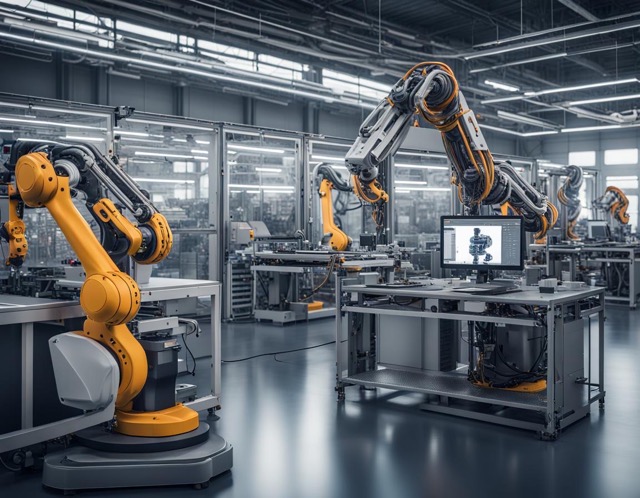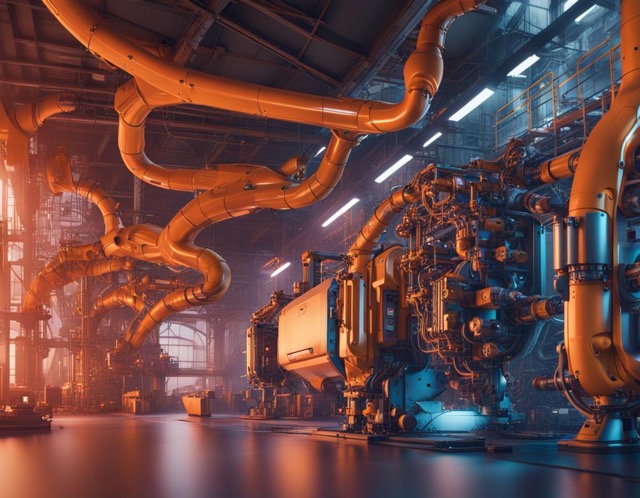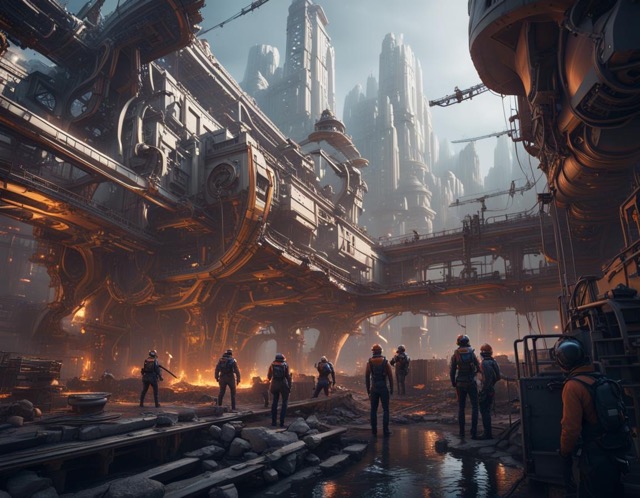This blog post is based on the section of paper The Potential of Generative Artificial Intelligence Across Disciplines: Perspectives and Future Directions published in the Journal of Computer Information Systems, Taylor & Francis, ABDC: ranked A.
The fourth industrial revolution focuses on digitalization, automation, and connectivity in manufacturing. Generative AI, a key technology in this revolution, generates human-readable output from text input, offering significant potential for manufacturers. It enables exploring optimal solutions, creating unique outputs based on specifications and costs, and achieving efficient lead times by combining design and production options.
| How Generative AI can potentially transform the Manufacturing Industry |
|---|
 |
| This image illustrates how generative AI is used to create a 3D model of a part on a computer monitor, while robotic arms perform the fabrication tasks on the factory floor. |
Opportunities
In the manufacturing industry, a significant challenge is the shortage of skilled workers due to factors like an aging workforce and evolving technology. Generative AI offers a potential solution by bridging this skills gap. By investing in this technology, industries can train workers on new skills through personalized learning, making the learning process more effective.
Generative AI also aids in design optimization, allowing engineers and designers to create personalized objects and optimize designs for manufacturing processes. Engineers can prompt the system, create design variations, and adjust constraints, identifying optimal solutions compatible with multiple suppliers' capabilities.
| Potential of generative AI in the manufacturing industry |
|---|
 |
| Generative AI has a lot of potential in the manufacturing industry, such as enabling faster and cheaper prototyping, enhancing customization and personalization, and improving efficiency and sustainability |
Additionally, Generative AI enables manufacturers to anticipate disruptions by simulating impacts and identifying defects in real-time, reducing manual inspection and speeding up production. Synthetic data can be used for simulations, assisting in decision-making for potential disruptions like natural disasters and transportation blockages.
By integrating generative AI, manufacturers can address skill shortages, enhance design processes, and proactively manage disruptions, ushering in a new era of efficiency and innovation in the industry.
Challenges
To successfully implement this technology, companies must invest in compatible computing infrastructure and data storage. Manufacturing sites often use diverse machines and tools, making it a challenge for engineers to ensure seamless integration. Lack of a standardized framework can require substantial initial investments in technical capabilities.
Generative AI relies on vast amounts of data for learning, but obtaining high-quality, relevant data is a hurdle. The system's ability to capture underlying patterns hinges on the quality of the training data. In dynamic manufacturing environments, AI models must be robust and adaptable. Ensuring reliable outputs is crucial, and explainability is necessary for contextual insights.
Privacy, liability, and copyright concerns surround generative AI adoption. Firms must safeguard data privacy, prevent unauthorized use, and address ownership disputes arising from AI-generated content. The lack of clear regulations raises legal uncertainties, potentially leading to control by powerful corporations.
| Challenges of generative AI in the manufacturing industry |
|---|
 |
| Generative AI can offer new possibilities and opportunities for the manufacturing industry, but also require careful consideration and regulation |
Moreover, the advancement of generative AI raises concerns about widespread job displacement, affecting both manufacturing and other labor-intensive sectors. Workers need training and reskilling to effectively collaborate with this technology. The potential of generative AI lies in its ability to respond to natural language prompts, emphasizing the need for clear and structured instructions from users.
In navigating these challenges, companies must balance technological advancements with ethical considerations, ensuring a future where AI enhances productivity while prioritizing data privacy, job security, and regulatory clarity.
Research Agenda
Practical research!
Manufacturers keen on integrating generative AI need insights into credible applications and best practices for optimal benefits. Key areas like job impacts, security, privacy, biases, and environmental effects need focused study.
Research on workplace integration, employee training, and ethical considerations is essential. Crafting guiding frameworks and policies is crucial to navigate the ethical complexities and ensure responsible use of generative AI in the industry.
Note: All images are generated on SDXL1.0
| The Future of generative AI in the manufacturing industry |
|---|
 |
| Practical tips on how to get started with generative AI in industrial manufacturing, such as identifying use cases, building capabilities, establishing governance, and collaborating with partners are needed |
References
Keng-Boon Ooi, Garry Wei-Han Tan, Mostafa Al-Emran, Mohammed A. Al-Sharafi, Alexandru Capatina, Amrita Chakraborty, Yogesh K. Dwivedi, Tzu-Ling Huang, Arpan Kumar Kar, Voon-Hsien Lee, Xiu-Ming Loh, Adrian Micu, Patrick Mikalef, Emmanuel Mogaji, Neeraj Pandey, Ramakrishnan Raman, Nripendra P. Rana, Prianka Sarker, Anshuman Sharma, Ching-I Teng, Samuel Fosso Wamba & Lai-Wan Wong (2023) The Potential of Generative Artificial Intelligence Across Disciplines: Perspectives and Future Directions, Journal of Computer Information Systems, DOI: 10.1080/08874417.2023.2261010